NM3205 / Digital Culture and Art / 2016-17 / Semester 2 / NUS
Don't wanna be here? Send us removal request.
Text
Week 13 - Homage Project Reflection
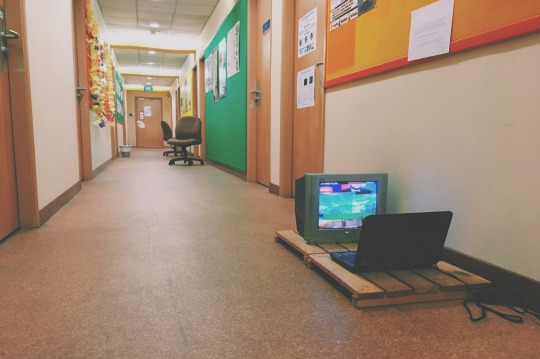
Black Box, White Noise (2017). CRT TV, laptop, digital video. Installation view (temporal) at CNM Office, 11-12 April 2017.
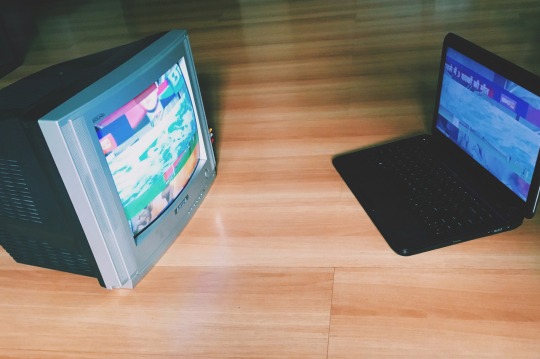
Black Box, White Noise (2017). CRT TV, laptop, digital video.
youtube
Video work for Black Box, White Noise (2017). 1min 10s.
Process
Using Don DeLillo’s quote from White Noise as a starting point, I began to think of ways to communicate the anxiety and panic from informational saturation -- something that communicated the trepidation in the almost Beckettian wait for a catastrophe. Building upon what I’d set out to achieve with Task 1, where this saturation of media was applied to the idea of individual identity, I wanted to apply this concept more generally to human experience. Whereas the work I created for Task 1, Don’t leave me to my own devices, existed purely in the digital realm, I wanted concepts to manifest in physical form for Task 2.
As such, I began thinking of ways in which it could take physical form -- I mentioned Nam June Paik during class discussions, and feedback was that his installations tended to rely on density and mass, something I could not replicate with limited resources.
Another point brought up was the means in which I could communicate the emotional experience to the audience -- how do I convey this anxiety? Thinking about these issues raised led me to look to Nam June Paik’s more pared down installation works, such as TV Buddha, which relied on choice of objects as opposed to mass of objects. I also decided to rely upon the use of sound to communicate the anxiety -- perhaps unpleasant, static noises could be weaved into the installation, building on the idea of white noise.
With these ideas in mind, I came up with a simple sketch of how the installation could take form.
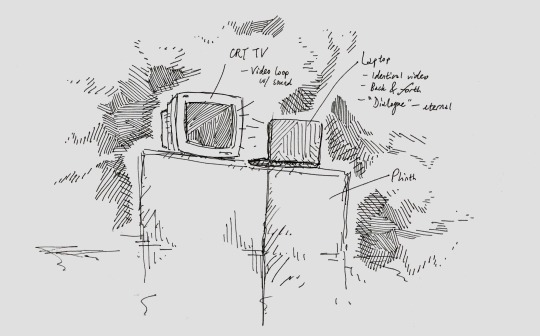
I then began obtaining materials -- a CRT TV, a laptop, and something that could serve as a plinth. Wooden apple crates would serve as plinths (the processed wood acting as an interested material counterpoint to the electronic equipment). Several rounds of experimentation were needed for this process -- to get the equipment working, placement of the materials, wires, adapters, plugs needed, even repurposing an old PS2 as a DVD player because of its portability.
After being certain of the workability of the physical installation, I moved on to creating the video. This involved the use of video editing software and the use of found footage from Youtube.
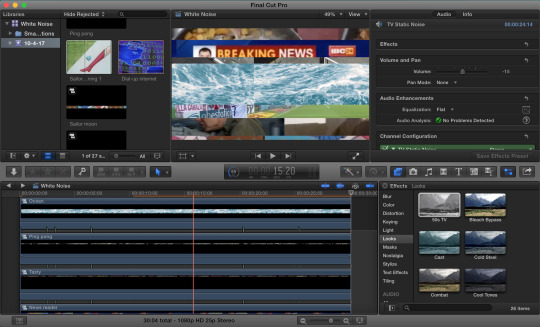
The choice of videos to splice into the video work was selected on the basis of its visual texture, colour, and greater implications. These implications or symbolisms were meant to be as eclectic as possible -- news programmes, cooking sequences, entertainment programmes, images of nature. A juxtaposition of serious or neutral with the banal, mindless or facetious. The list of videos are as such:
TASTY COMPILATION PART 1 https://www.youtube.com/watch?v=88WTy6pgrQE
Chhattisgarh TV Anchor Supreet Kaur Reads Her Husband’s Death On Live TV (FULL VIDEO) https://www.youtube.com/watch?v=kCuZyFld-GU
Ping Pong Trick Shots 3 | Dude Perfect https://www.youtube.com/watch?v=UeG1ftTmLAg
Blue Ocean Waves Slow Motion - Free Stock Footage https://www.youtube.com/watch?v=KGhsX1GDibM
YAMIL ASAD 2015 - Media Punta - Volante Ofensivo.mp4 https://www.youtube.com/watch?v=ZRyB4K1asqw
The Mummy - Official Trailer #2 [HD] https://www.youtube.com/watch?v=GzorZUuZqEI
Sailor Moon Opening 1 https://www.youtube.com/watch?v=b8Rvwu8Wykw
After splicing the videos together, I began to corrupt the video’s data -- a process of databending using Audacity. Importing the video footage as raw data and editing the content allowed me to produce authentic glitch effects.

The process of glitching itself required several rounds of experimentation, and I edited the glitched footage in with the original. Now that I had the footage, sound was another aspect that I had to create. This was synthesised through the use of sounds from old dial-up modems and static -- a sufficiently disturbing and otherworldly combination of sounds.
And finally came the installation process -- putting the artwork in place at the CNM office.
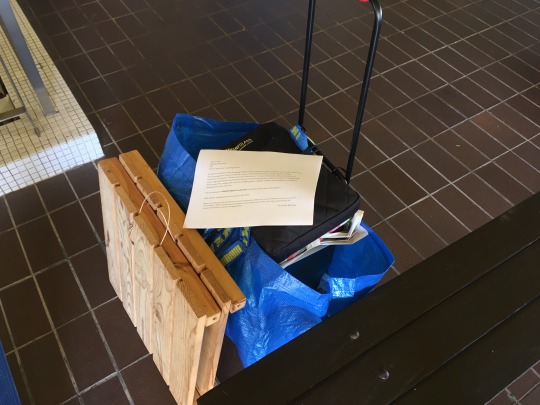
Lugged everything over to the office with a mini trolley and finally set everything up. The installation was then left for viewing until the morning of the next day.
Brief Write-up
Black Box, White Noise 2017 CRT TV, laptop, dual-channel digital video
An ephemeral installation/video work paying homage to the concept of brain fade as outlined in Don DeLillo’s White Noise, this work emerges from a fascination with the concept of informational saturation. Emphasising the “incessant bombardment of information” faced by the modern individual vis-à-vis mass communication, the work’s utilisation of moving image, databending and sound serve to communicate the unceasing “panic, noise and interference” engendered by these incessant flows; a dialogic back-and-forth of images, graphics, tragedies, statistics, data, and flows as a consistent, inescapable process from old to new.
Part of a submission for NM3205 Digital Art and Culture by Professor Flude, Marcia Nancy Mauro.
Full Write-up
Black Box, White Noise (2017) is a video work and ephemeral installation emerging from my fascination with the concept of informational saturation; paying homage to the concept of brain fade as outlined in Don DeLillo’s White Noise. Emphasising the “incessant bombardment of information” faced by the modern individual vis-à-vis mass communication (66), the novel suggests that the constant stream of data, images, and media has textured human life to the extent that an almost spiritual dependency upon the digital is forged within the individual.
Because we’re suffering from brain fade. We need an occasional catastrophe to break up the incessant bombardment of information. [...] The flow is constant, [...] Words, pictures, numbers, facts, graphics, statistics, specks, waves, particles, motes. Only a catastrophe gets our attention. We want them, we need them, we depend on them (66).
The electronic and the artificial become us – it both comforts and alienates. The novel conveys this ironic dichotomy by creating an atmosphere of unceasing anxiety, an unending trepidation that accompanies the overall impotency of the modern individual in coping with this saturated existence. So frighteningly expressed that one can only imagine the extent to which these feelings may have grown with the rapid growth of new media – and the scale of the catastrophe this necessitates before we are shaken from brain fade.
In his lecture, Black Box, Black Bloc, Alexander Galloway describes the hypothesis of the “fully programmed and also re-programmable” biological bodies of the cybernetic city – an eerie prediction of society that seems mere continuation of DeLillo’s expression of modern being (2). How does one integrate such incessant progressions and flows into a bearable form of existence? Galloway states the appropriate response to such a cybernetic city: “panic, noise, and interference” (2). It is a revolt that relies on a specific invisibility, a non-invasive blackness. Almost akin to observing a black box – the mystical cypher “without windows”, waiting to be decoded, deciphered, revealed to be rational (3). It is a “new approach to knowledge” – where only inputs and outputs certain, we allow the object to remain “opaque”, and we make every judgment based on observation, with “no access to our or anyone else’s inner life” (5-6).
My artwork thus draws on both concepts – of panic, noise, interference, and of looking, gazing, observing – in an attempt to engage with the incessant flows causing brain fade. The viewer is made to watch; to observe images that come in fragmented splices, but fill and overwhelm the screens unceasingly. They move across the frame, almost screeching with static and noise, as if to announce their appearance, a looping video that flickers between states. It is, as Olia Lialina suggests, an “infinite séance”; a looped screening that exists for however long the artwork is installed. It becomes a “formless story” about the modern individual’s relationship to the unending streams of information. More literally, a stream of water cuts through the images presented; flowing through as representational expression of the flows of information. Just as financial flows are symbolised by water in Hito Steyerl’s Liquidity Inc., so are informational flows represented by the same element in this work. The stream is panicked and churning – communicating the same urgency as all the other flickering, fragmented images. They cut into frame at different speeds, interfering – clambering to be seen, heard by the next, a communication of unceasing anxiety.
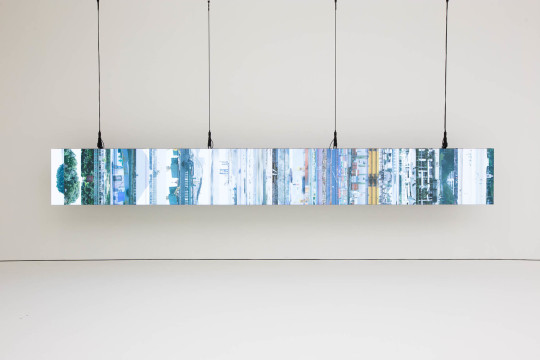

Figure 2. Charles Lim, SEA STATE 7: sandwich (2015). Single-channel HD digital video. 5 minutes.
In terms of formalistic reference, the video work draws upon Charles Lim’s SEA STATE 7: sandwich, which utilises a similar aesthetic of spliced moving image to communicate the complexity and constancy of an issue. Using images of water and the seaside, it uses ever-shifting landscapes to communicate the same sense of contested meanings of space and territory in relation to Singapore’s use and importation of sand. Movement in my work is thus an expression of the trepidation; an anticipation of the catastrophe that is to come, heightening a sense of anxious escalation.
Even more salient is its physical form as installation, which utilises a television and laptop facing the other directly, locked in an almost dialogic loop of moving image. This ceaseless cycle is reference to Nam June Paik’s TV Buddha, though facing the box of the TV is instead now a laptop, the “splayed open” black box instead of the image of the Buddha (Galloway 3). Images of the spiritual are not present – the black box perhaps becomes the intermediary for a spiritual experience.

Figure 3. Nam June Paik, TV Buddha (1974). Installation with closed-circuit video camera, monitor, and sculpture.
Works Cited
DeLillo, Don. White Noise. Penguin, 1999.
Duvall, John N. "The (super) marketplace of images: Television as unmediated mediation in DeLillo's White Noise." Arizona Quarterly: A journal of American literature, culture, and theory 50.3, 1994, pp. 127-153.
Galloway, Alexander. “Black Box, Black Bloc.” Culture and Communication, 2010, cultureandcommunication.org/galloway/pdf/Galloway,%20Black%20Box%20Black %20Bloc,%20New%20School.pdf.
Lialina, Olia. An Infinite Séance. 2007, art.teleportacia.org/observation/infinite-seance.html.
London, Barbara. "Time as Medium: Five Artists' Video Installations." Leonardo 28, 1995, pp. 423-426.
0 notes
Text
For Task 2 - Reflection on Databending
youtube
Though we were taught some basic data manipulation using TextEdit on an image file, I was interested in glitches produced within moving image files such as videos, as moving image is my preferred medium. I wanted to create an authentic glitch effect that would overwhelm a video over time, as opposed to using the rather false-looking filters provided by editing software.
Rummaging around, I found this tutorial about databending video files using Audacity -- a free software usually used for editing sound. Apparently, it is possible to import a video file as raw data, and the programme depicts this as audio waveforms. Applying certain effects to the middle section of the video causes the data to corrupt, creating glitches in the moving image form.
After some trial and error, I was finally able to glitch my videos, which were utilised in my final product. Perhaps as a record, these are the settings used to import and export the clips used in my final video (the settings are important such that the video file is not wholly corrupt and still viewable, glitches and all). When importing file (attempted file types - .mov, .m4v): Encoding: A-Law Byte order: No endianness Channels: 2 Channels (stereo) When exporting: Header: RAW (header-less) Encoding: A-Law
0 notes
Text
For Task 2 - Reflection on the Infinite Séance

Olia Lialina’s text, An Infinite Séance, was particularly salient to me. It raised some rather pertinent issues faced while exhibiting video works, which is important to me considering my use of video and my desire to present video works in a way that is not static -- a projected image or a screen to gaze at.
She speaks of non-linear storytelling in video works:
In an exhibition hall, the screening has no beginning, and no end. The possibility of a viewer entering the hall exactly at the beginning of a film is infinitesimally small. The possibility that someone who has arrived in the middle of the screening will not only stay until the end, but also watch the beginning that he or she has missed, is smaller still. This is why artists tend to choose formless stories, without a clear beginning or ending.
She points towards the idea of the spatial film -- a means of using the space one exhibits the work in.
It is also necessary for artists to work with the space they are given: they can try to use it to add new meanings to what they are showing, or toy with the idea of "spatial film", splitting their image into several screens or projections, [...], using different angles or soundtracks.
I wanted my video work to be grounded in a physical reality as an installation. It made me think of (1) what spaces I could use to present my work in, now without the space of the ArtScience museum and (2) how I could present my work in an interesting manner that added to the work.
These questions would guide the ways in which my installation would manifest.
0 notes
Text
For Task 2 - Reflection on Don DeLillo’s White Noise

A novel I enjoyed very much when I read it about two years ago while I was still in the army. I was captivated by the means through which Don DeLillo communicated the impotency of the modern man and the senselessness of the contemporary world we live in, all while grounding it in very human desires and emotions, culminating in a confrontation with the universal fear of one’s mortality.
The quote that continually rings through my mind is that of brain fade, which I believe I have repeated enough times on this blog such that it is no longer necessary. But it is the litany of components and the escalation into the intangible that is my favourite part of the quote:
Words, pictures, numbers, facts, graphics, statistics, specks, waves, particles, motes.
So saturated are we with informational flows that it exists on a metaphysical level -- the invisible and unnoticed. But all that is not visible is not invisible, per se -- their effects are always felt upon us. In a sort of desperate, numbing way.
0 notes
Text
For Task 2 - Reflection on Black Box, Black Bloc

Facial recognition and autoblur software, Google Street View, 20 Rue de la Vicarie, Saint Brieuc, France.
In a review of my previous work for Assignment 1, Prof suggested I look the idea of the black box, and how computers can be seen to be a manifestation of this concept. Provided the lecture by Alexander Galloway, I began my attempts to understand this conception of the computer interface.
It is a difficult reading -- he begins by referring to Hegelian dialectics (Abstract - Negative - Concrete), and the process of Aufhebung (the state undergone between Negative and Concrete -- translates directly as being the process of sublation/assimilation/taking only the good and improving the flawed). He mentions the problems that other groups speak of -- the dystopian-esque cybernetic hypotheses, the panic, noise and interference. He brings in how these hypotheses engender an invisibility, a blackness. And that brings us to the concept of the black box (an object wherein inputs and outputs are certain, but the processes within that make these transformations are unknown).
[...] a new approach to knowledge, one that abdicated any requirement for penetration into the object in question, preferring instead to keep the object opaque and to make all judgements based on the object's observable comportment. In short the behaviorist subject is a black-boxed subject. The node in a cybernetic system is a black-boxed node. The rational actor in a game theory scenario is a black-boxed actor.
I wanted to take this “new approach to knowledge”, this non-invasive observation, and apply such an idea to my work. I only hope to do such concepts justice.
0 notes
Text
For Task 2 - Reflection on Nam June Paik

Nam June Paik, Electronic Superhighway: Continental U.S. (1995). 49-channel closed circuit video installation, neon, steel and electronic components, approx. 15 x 40 x 4 ft.
Considered the godfather of video art, Nam June Paik’s works serve as important influence on what I hope to achieve. His works deal with concepts of transmission and technology, along with its ensuing impact on the individual. In thinking of ways in which my work could take physical form, I mentioned Nam June Paik during class discussions, and feedback was that his installations tended to rely on density and mass, something irreplicable with limited resources (and with just one CRT TV).
As such, I looked through his works to find a more pared down piece I could draw upon as inspiration for form. TV Buddha could then serve as a starting point for my installation.
0 notes
Text
Week 12 - Assignment 2 Prototype
youtube
A simple prototype testing the feasibility of a physical installation. The final form will change in appearance of course.
Further posts above will demonstrate the thought processes and concepts that went into this prototype -- reflections about various readings, artists, and concepts.
0 notes
Text
Week 10 - Random Blends: Interceptions - Reflection

Yvonne Wong, Trigger (2016).
As someone fascinated by curation and exhibition design, I looked forward to experiencing the culmination of other CNM students’ efforts to execute an exhibition. Interceptions is an ambitious theme -- the idea of laying bare “alternative or silenced discourses” in society via digital and interactive art is a laudable but tricky thing to achieve.

Hafiz Karim and Arumi Ho, Revisioning (2017).
I entered the reception space first and took a look around at the works there -- this included Revisioning, Dandelion by Weiquan Lu, and Newgame by Dr Nancy Mauro-Flude. I was then told of the segmentation of the space into three, and decided to enter the left-most room first.

The three spaces of Dissonance, Resistance, and Disruption are clearly delineated by the changes in atmosphere -- one with white walls and bustling with activity from the various game booths. The reception area as a transitional space. And the final room which was significantly darker, also featuring a more interactive medium in terms of digital games.
Several things stood out to me -- one would be the underutilisation of space. The works were usually placed along walls and did not take advantage of the viewing space to create a sense of directionality. Certain conventions expected from an exhibition were not present -- for example, printed collaterals with descriptions of the works did not include the artists’ names; which I found a rather odd exclusion.
However, I did find myself sitting down to engage with the games, which I enjoyed overall.

Listen (2016).
Response. One of the games I found rather enjoyable because of its simplicity. I sat down to play through till the end of the game -- I was fairly entertained by its concept.
Description. A video game rendered in pastel hues, it has a simple, child-like appearance. Simple to control as a 2D-side scroller, the game delivers instructions for the player to follow, such as the path to take, enemies to attack, and so on. Interjecting levels are quotes (which I found cloying at times).
Analysis and Interpretation. An attempt to explore themes of nonconformity through the disruption or deviation from expected societal norms. A simple theme, which makes it an interesting concept to execute in the form of a game. Other games in the area tended draw upon heavy concepts that seemed to reach beyond what students could grasp, so the scope of this game felt appropriate and was free from the heavy-handedness that could have entailed. Utilising the ludic trope of the in-game guide, the player is afforded the opportunity to either follow the textual instructions or stray from them. Playing the path of the non-conformist transforms the landscape to become far more bright and cheery looking -- communicating perhaps the positive aspects of undertaking less-treaded paths.
Evaluation. I enjoyed the intelligent use of the ludic trope of an in-game guide or narrator which the player is then given the autonomy to ignore or resist. Such game mechanisms allow for greater emergent moral decision making -- games such as Papers, Please have utilised such mechanisms to great effect. What worked for me was the scope and entertaining means through which this is communicated. Of course, one must always note that in gamifying such concepts, a certain level of nuance is lost.
0 notes
Text
Week 9 - Forum Responses
To Sean Poon in [Objects,] Talk to Me:
Hey Sean, love the Housekeeping quote – one of my favourite novels. “Why must we be left, the survivors picking among the flotsam, among the small, unnoticed, unvalued clutter that was all that remained when they vanished, that only catastrophe made notable?” – Marilynne Robinson, Housekeeping I like the grounding of your work in a local context, and it's great that you mention Rem Koolhaas; you might want to draw upon his essay, Singapore Songlines: Portrait of a Potemkin Metropolis… or 30 Years of Tabula Rasa, which expounds on themes that could be interwoven with what you propose. He speaks of Singapore as being built up from blank slate, with landmarks and histories erased, whole communities uprooted and moved for the construction of a pristine, generic, artificial, and regulated First World city. I imagine some historical parallels may be drawn to the hidden demographics of which you speak – what communities are written over in the palimpsest of state-sanctioned narratives? What are the "hidden transcripts" that may emerge from our engagement with these communities and histories? Singapore is not a mere "Potemkin city", as Koolhaas may have written. A summary of the essay may be found here http://www.qlrs.com/essay.asp?id=805 While your work centres on the idea of certain objects as being replete with significance vis-à-vis contestation of space, I do feel like space and architecture are particularly salient themes in what you propose – I'm thinking of local artist Debbie Ding's work, Rules for the Expression of Architectural Desires, which is a collection of speculative rules and schemes for the urban design of a city, accompanied by a video work. It considers our relationship to built urban environments; how its supposed materiality manifests in entirely immaterial concepts and urban experiences. It might be interesting to juxtapose these themes with the experience of the hidden demographics you mention.
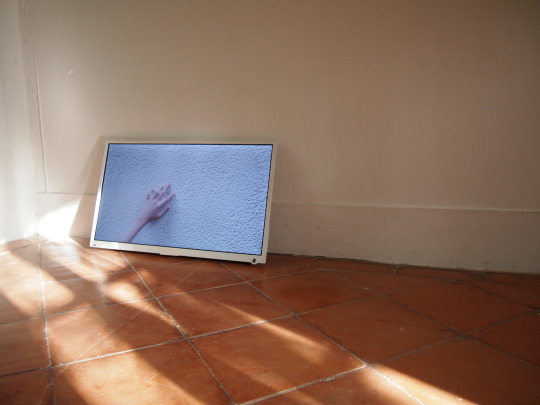
Debbie Ding's Architectural Desires (2015) [Image source: http://dbbd.sg/works/architectural-desires.php] The video work may be viewed at https://youtu.be/d59H6uIE0sM Hopefully the works I recommend aren't too tangential and are at least of some interest to you. All the best for your project – sounds really promising.
To Geraldine Gan in Digital Marketing / Cyberbullying / Digital Interior Design:
Hey Geraldine -- I find your desire to combine concepts of marketing and recycling a unique synthesis. I see lots of potential for an artwork dealing with themes of environmentalism -- local artist Ong Kian Peng's Too Far, Too Near deals with the issue of climate change by creating an immersive space within which a viewer may contemplate global warming. A 2-channel video displays the image of melting glaciers, while electronic components and metal structures with metal balls slowly tilt and create subtle noises reminiscent of ice shifting and dissipating.
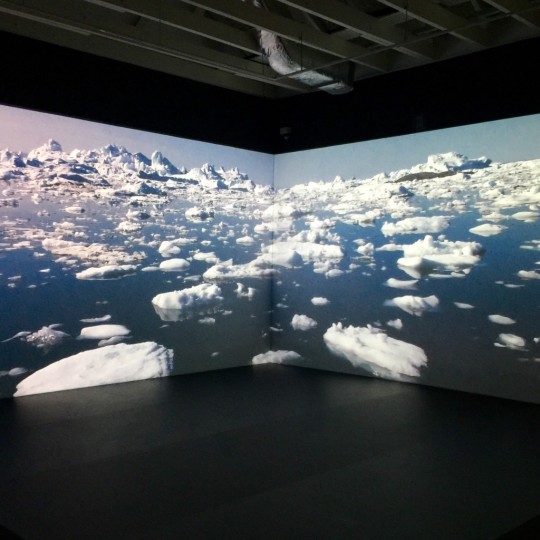
Ong Kian Peng, Too Far, Too Near, 2015, DC Motor, Metal balls, Steel structure; 2-channel video with 3-channel sound, Dimensions variable, Duration: 15 mins. [Image source: http://www.artitute.com/2015/09/27/singapore-got-art-talent-a-closer-look-at-the-2015-edition-of-the-presidents-young-talent/] Perhaps this may give you an idea of how to go about creating spatiality even with two-dimensional videos, as Jacquelyn has raised as a point -- tapping on electronics and digital mediums to manipulate space and sense. The idea of marketing can perhaps be linked to greater themes of capitalism and consumption -- though such are concepts often seen counter to environmentalism. I recommend the book This Changes Everything: Capitalism vs. the Climate by Naomi Klein, which touches upon the idea that the power of corporations (fueled by capitalism) prevents serious reforms to stop climate change and protect the environment.
To Aloysius Kow in Our everyday society:
Hey Aloysius -- interesting that you're applying the concept of surrealism to contemporary contexts and narratives. Here are some local artists that have dealt or drawn upon the iconography of everyday local scenes and abstracted them into something surreal or absurd. Local artist Dorcas Ng's work, Commoners, was inspired by looking up at HDB buildings at night -- the lights and silhouettes from each unit suggesting a presence and an entire narrative we are not privy to. To elicit this same sense of curiousity and wonder borne from observation of everyday space, she created three box-like sculptures with electronic elements such as flashing lights or kinetic mechanisms, creating surreal, dreamlike re-imaginings of the HDB space. They are displayed in a specific manner: hung up high near the ceiling, such that guests must peer into each surreal HDB space from below, recreating the idea that we are catching a glimpse into lives different from our own. Ordinary becomes dream space, with each sculpture accompanied by a peculiar narrative written by the artist --
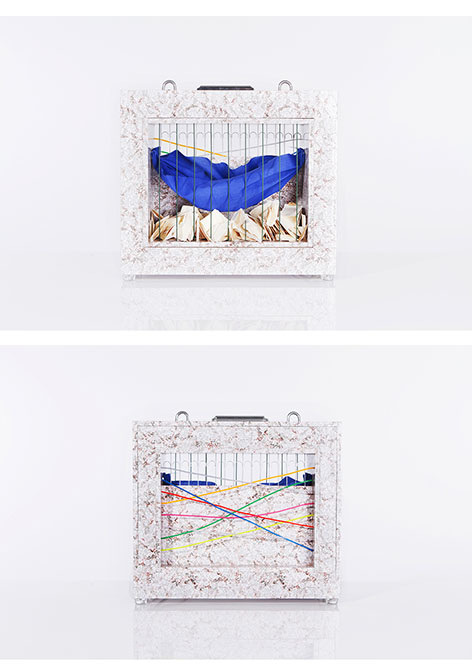
[Image source: http://www.aheeoee.info/COMMONERS] Commoner A Wood, metal, fabric, electronics 2015 "Commoner A wants to enter the lucid dream state in a quicker time. He decides on a hammock as a representational medium to transcend states of consciousness. Plus he is in deep need of active inspiration due to the nature of his job (without the need for drugs). 'One needs to constantly work hard at being creative.'"
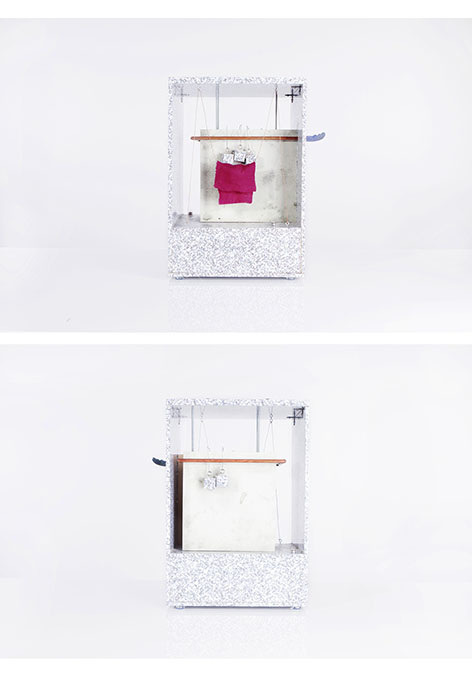
[Image source: http://www.aheeoee.info/COMMONERS] Commoner B Wood, metal, fabric, electronics 2015 "Commoner B is moving out, albeit secretly. Large careless movements will alert the big-mouthed neighbours and chaos will ensue. The laundry should act as a good cover for all this commotion. 'Rain or shine, leave the laundry out.'"
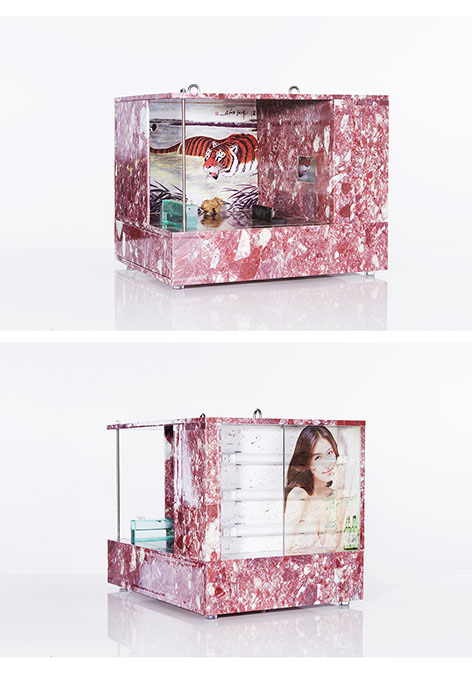
[Image source: http://www.aheeoee.info/COMMONERS] Commoner D Wood, metal, stone, electronics 2015 "With a ceiling high mural of a Chinese tiger in the living room you can kind of imagine the ferocity and desires of Commoner D. Living behind a billboard doesn't make his life easy in fact his speech and behaviour have to be carefully planned to avoid being caught. 'No traces should be lying around not even in my habitat.'" As such, her works demonstrate an engagement with contemporary local images (the HDB) along with stories (imagined narratives of heartlanders). Another work playing with the iconography of everyday objects and scenes from a local context is Kray Chen's Waiting on a Bird, which is a sculpture and video work reminiscent of a mahjong game -- except all four players are waiting for the same single tile which is nowhere to be found but on the television screen before them, a game that is impossible to win. Again, the everyday is taken and transformed into an absurd, surreal situation.
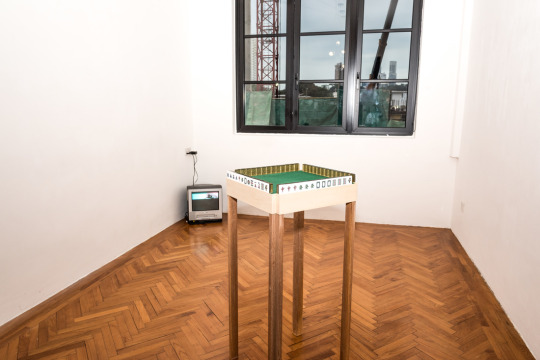
[Image source: http://www.kraychen.com/fortune-by-chance.html] I suppose these artworks would guide how I would approach creating an artwork regarding the context of contemporary Singapore society -- taking images or situations that have significance to us and abstracting or distorting them to create a surreal situation that invites viewers to pause and ponder. These works can then be the entry point to several narratives, whether subtle or embedded within the artwork itself. Hope these references give some ideas! Do check out more works by local artists, I imagine a lot of the themes they deal with are particularly salient to our lives.
Individual Forum Post
““[W]e’re suffering from brain fade. […] The flow is constant, […] Words, pictures, numbers, facts, graphics, statistics, specks, waves, particles, motes.” - Don Delillo, White Noise I am interested in the idea of informational saturation as brought about by digital culture -- emerging from a desire to pay homage to the concept of brain fade as outlined within Don Delillo's novel, White Noise. Satirising consumer culture, one aspect of the novel is the constant barrage of information faced by the modern individual vis-à-vis mass communication. A continual sense of anxiety, along with the overall impotency of the modern individual in coping with this saturation is frighteningly well expressed. One can only extrapolate the extent to which these feelings may have grown with the advent of new media. Building upon these concepts explored in task 1, I wish to step beyond the concept of individual identity as affected and effected by these flows of information and wish to examine them within the greater general context of Singapore. I am particularly interested in the idea of communities existing within these flows of information -- as imagined explorers, the sea people of an informational age, attempting to navigate tides of information. This plays upon the Manuel Castells' concepts of the space of flows, wherein physical space is seen as site for physical infrastructure allowing for metaphysical informational mobility -- here, playfully reimagined are these informational "flows" as something far more tangible and elemental; as if traversing oceanscapes. This is inspired by Hito Steyerl's work, Liquidity Inc., wherein themes of capitalism and financial flows are expressed through the metaphor of water. The reimagining of human constructs such as markets, information, and data as manifest in a natural form such as water is an interesting, if absurd exercise.
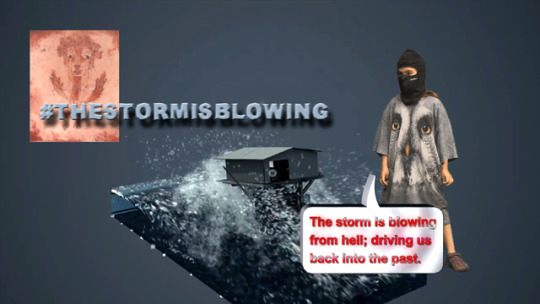
Hito Steyerl, still from ‘Liquidity Inc.’ (2014). Image source: http://www.aqnb.com/2014/03/05/hito-steyerl-the-ica-liquidity-inc/ The artwork I hope to develop will be an attempt at abstracting and distorting these informational flows and saturation, demonstrating the desperate attempt to integrate these flows into a bearable form of existence. Perhaps we can ask ourselves what are the ways in which we cope -- or fail to cope -- or do not need to cope -- with the constant flows of information we receive on a daily basis, and how these experiences can be expressed in an abstracted form.
0 notes
Photo
Study: visual textures of digital art -- QR codes; colour; gradients; pixel guides

Felipe Pantone
75 notes
·
View notes
Text
Week 8 - Source Materials - Form, Content & Context
Gather source materials for preparation towards Homage Project. You could do this in 3 ways:
From form to content: Collect a quantity of a single type of material that appeals to you because of its formal qualities. This could range from digital artefacts, recyclables such as old newspapers or plastic bags, to objects from the natural environment such as rocks or plants, or collections of items such as fabrics, buttons, old wall paper etc.
OR
From content to form: Find a piece of text that inspires you because of its content, for example, a line from a poem or song, a text message, a tweet, a status update a newspaper headline, the title of a book of film, or something you heard someone say.
OR
From context to form: Find an object that appeals to you because of its implied historical or narrative context, for example, a photo, an ornament, a toy, a (small) piece of furniture or an item of clothing. Source the object from home, or wherever you like.
Use whatever object, material or piece of text you have selected to develop sketches, diagrams or models for three different works of art or design. You will need to consider a range of formal options for developing your ideas. These may be more traditional, such as photography, collage or drawing, to the more experimental, such as installation, performance, video or 3D constructed objects. As you do this exercise, focus on the relationship between form, content and context – what media or formal strategy would best convey your ideas?
FROM CONTENT TO FORM:

The quote from Don DeLillo’s quote has left such an impression on me that it would be rather accurate to say the content has influenced the form of which Task 2 will take. From the source materials outlined in the earlier post below, the physical form of CRT televisions and video works will be informed by the message (content) I hope to communicate.
0 notes
Photo
Study: three-dimensional forms in digital art -- playing with textures -- surreal juxtaposition of geometric/organic shapes -- colour

stay dead and out of this world, Troy Ford, 2017
96 notes
·
View notes
Text
Week 8 - Ten Things As Source Material
Find a minimum of 10 things (source material) which is meaningful and connected to your life. Don’t go looking too far, bring the things you would naturally collect/keep. Write a journal entry about the source materials, in whichever way you see fit. The items could be everything and anything which you would otherwise gather for producing work. This could be text, images, sound recording, objects, experiences and many other things.
BIBILIOPHILIA

1. WHITE NOISE BY DON DELILLO
A novel of great personal significance. Follows the professor Jack Gladney in a part-academic satire, part-dystopian emergency, part-meditation upon society’s fear of mortality. Darkly comical and incisive, it propounds some fascinating insights into contemporary living.

2. INFLAMMATORY ESSAYS BY JENNY HOLZER
A series of posters by artist Jenny Holzer featuring 100-word texts that were pasted throughout New York City. Inspired by political figures such as Mao Ze Dong and Vladimir Lenin the series is meant to be provocative; espousing strong ideologies. Urgent and powerful -- I enjoyed the use of language in this work.
3. RED RIBBON (FRAYED)
A visual marker to signify my progress in a novel -- a symbol of the importance of literature within one’s life. It is frayed from repeated use over several years.
KINĒMA

4. CRT TELEVISION
An artefact -- but not truly. A visual reminder of the ever-changing, rapidly-progressing means of communication and transmission.
5. DVD STACK
Soon-to-be an artefact. But an important aspect of the Infinite Séance -- looping videos can be made using these old DVDs.
6. VIDEO FOOTAGE
Found footage begs to be interpreted. The process of selection is key here.
7. PLAYSTATION 2
A gaming console, now to act as a makeshift DVD player. An important component of the Infinite Séance -- a means through which the DVD is read. Portable and convenient.
QUALIA

8. MOLESKINE NOTEBOOK
A means of noting down one’s thoughts. Making a record of the intangible and fleeting is necessary to document the process of creation.
9. MEMORIES
Every work must incorporate an aspect of the self. Keeping a record of one’s memories, the act of retrieving these thoughts, ruminating and understanding the past is an important process. Allows for reflexivity and understanding.
10. UNCEASING TREPIDATION
Externalising interiority is an important aspect of one’s work. A certain emotion must be decided upon -- this will be what will fuel the work, what one will seek to express. From here, multiple discourses may be drawn upon, multiple meanings and symbolisms emerge.
0 notes
Text
Week 7 - “I am... I like... I want to...” Assignment Reflection
Don’t leave me to my own devices began with the examination of the half-statements “I am... I like... I want to...” -- definitive statements in response to far more complex questions such as who am I, what do I like, and what do I want to do. How does one compartmentalise and communicate self through responses to a few statements? To merely provide a litany of information would contribute to the “incessant bombardment” of information we face in this day and age.
““[W]e’re suffering from brain fade. [...] The flow is constant, […] Words, pictures, numbers, facts, graphics, statistics, specks, waves, particles, motes.” - Don Delillo, White Noise
Social media teaches us that identity may be reduced to skeins of demographic information -- name, age, sex, gender, occupation, education, country -- drop-down boxes, interests, likes, memes, images, video, status updates. We decimate ourselves to the basest components of being and hand ourselves out as data. The sense of self we occupy on online platforms are both replete with identity and absolutely vacant of it.
To explicate identity, especially digitally, is an inherently futile exercise -- attempt to elaborate self and one contributes only to the noise, the intangible qualia of self dissipates digitally to no consequence. Yet it is these failed attempts at claiming and documenting identity that live on online almost forever -- destined to outlive us.
“It’s hard to look at things directly. They’re too bright and too dark. Sometimes we need to see things through a screen. On one side of the screen memories fade. On the other, they glow forever.” - Wong Kar-Wai, There’s Only One Sun
My project centres around the idea of the digital dissipation of self -- a series of artistic experiments on various social media platforms, viewing each as vessels through which identity is distorted and expressed. Each platform (Tumblr, Twitter, Instagram, Facebook) is characterised by a key trait (tabula rasa, text, image, sharing), and the artistic experiment meditates upon each trait.
Don’t leave me to my own devices.
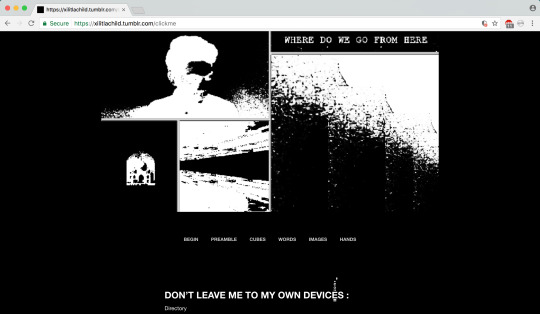
Don’t leave me to my own devices 2017 Social media platform interfaces, scanographs, moving image, hyperlinks Dimensions variable
I viewed this project as a digital wunderkammer -- a strange collection of artefacts of self scattered across multiple platforms, displayed within the vitrines of the online interface. To unify these multiple platforms, I created a landing page through which the project would be framed in.
http://xilitlachild.tumblr.com/clickme
A digital collage was created for the landing page, acting as a formalistic reference to Olia Lialina’s My boyfriend came back from the war (1991). Using a self portrait and photographs I had taken in the past, images were edited to become pixelated, monochromatic abstractions of their original selves. These serve to communicate the same dichotomous sense of repletion and emptiness of self, digitally: the artwork contains traces of self and identity, but they are abstracted, distorted to a low-fi state of irrecognition. These were framed with cutting grey lines reminiscent of browser windows; a statement on the compartmentalisation of identity.
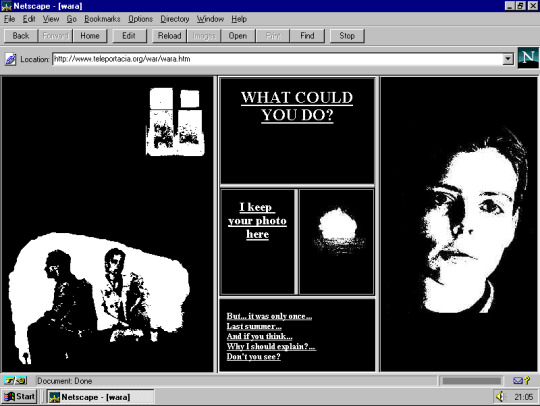
[Olia Lialina’s My boyfriend came back from the war (1991), which the digital collage on Don’t leave me to my own devices’ landing page references]
The directory allows you to navigate the works in certain order: preamble (It all pieces together), the artistic experiment with Tumblr (White Cube Series), then Twitter (Words fail us), Instagram (Images fail us), and Facebook (Man hands on misery to man). Who is the Xilitla Child?
A thread throughout the works within Don’t leave me to my own devices is the character of the Xilitla Child -- a false identity developed for this project, viewed as one of many permutations of self. Acting as reference to Rosa Menkman’s Xilitla (2014), I was intrigued by the real-world location of Xilitla which Menkman’s digital work was inspired by -- specifically, the garden of Las Pozas filled with surreal structures in the midst of a tropical rainforest. I was fascinated by the image of a child in the middle of this surrealist dreamscape and played with the idea of a child caught in a liminoid space between surreal physical landscape and distorted digital realm -- the concept of identity as both manifest online and off and the distortions and absurdities this entails.

I developed a simple logo of sorts for the Xilitla Child; a kind of visual symbol for the project across platforms.
Preamble.
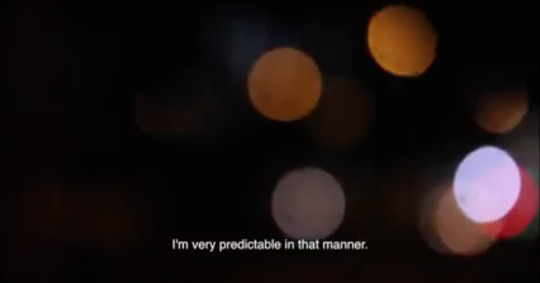
It all pieces together 2017 Single-channel video 2 min 25 s
The first work to be experienced is a short video essay It all pieces together which considers the act of experiencing art as a personal experience and the futility of attempting to record these experiences down. Just as we struggle to capture the essence of an identity, the nebulous nature of art escapes being pinned down and explicated precisely. This serves as the preamble to the rest of the works.
Created by editing together various decontextualised inserts from past narrative short film projects I have undertaken, the video takes on personal significance -- weaving together images in a dreamlike fashion, it mimics a stream of consciousness, or the process of retrieving distant memories.
Tumblr.
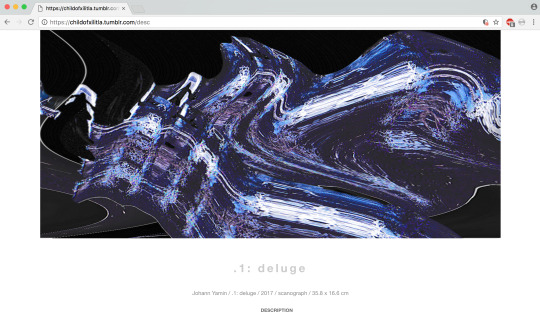
White cube series: .1: deluge 2017 Scanograph 35.8 x 16.6 cm
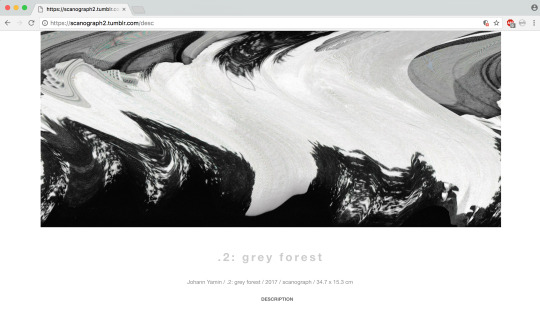
White cube series: .2: grey forest 2017 Scanograph 34.7 x 15.3 cm
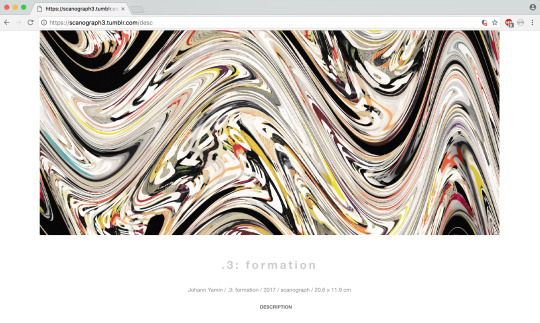
White cube series: .3: formation 2017 Scanograph 20.6 x 11.9 cm
On Tumblr we curate the visual artefacts that become us – a deliberate arrangement of aesthetics in an attempt to stabilise volatile identities. Because of the openness of the platform to me, I reimagine the interface as a white cube – a gallery space where works are displayed cleanly and neatly; meant as symbols of self.
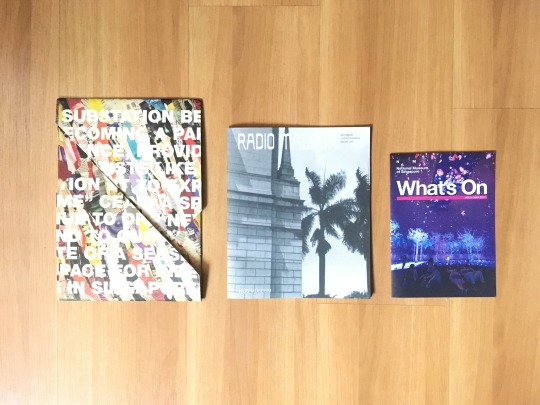
[Selected brochures to create distorted scanographs]
To create the images, I selected from the collection of brochures I have amassed from attending various exhibitions and events. Dragging them over the surface of a scanner while it attempts to capture a document creates a highly distorted scanograph, or a scanner photograph. I touched these images up and named them in relation to the different elements of nature they reminded me of.
In this sense, past art experience become transferred into the digital realm in a distorted fashion -- abstracted into visual form. The references to natural images further emphasise the power these experiences hold as an active force within one’s life.
Twitter.
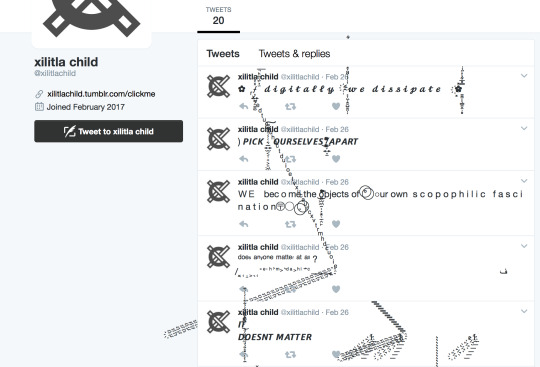
As a platform using text as the main means of communication, the work interrogates the idea of words and language and their ability to communicate, particularly in the digital sphere. More specifically, it dwells on the idea of the failure to communicate with words.
Inspired by Internet artist Glitchr, I wanted to replicate this symbolic corruption of the Twitter page through text. I thus drew upon the false identity of the Xilitla Child to create an account for such an experiment. Using glitch text generators, I experimented with various ways in which text within tweets could spill out into page. The failure to communicate does not necessarily mean a message has not been put across -- perhaps it just means it emerges in a strange distorted fashion. It spills out and affects the space around it, but how or why isn’t clear.
Instagram.
As a visual medium, Instagram is used to interrogate concepts of photographic truth as myth; the function of aesthetic beauty, and the tenuous link between real and imagined.
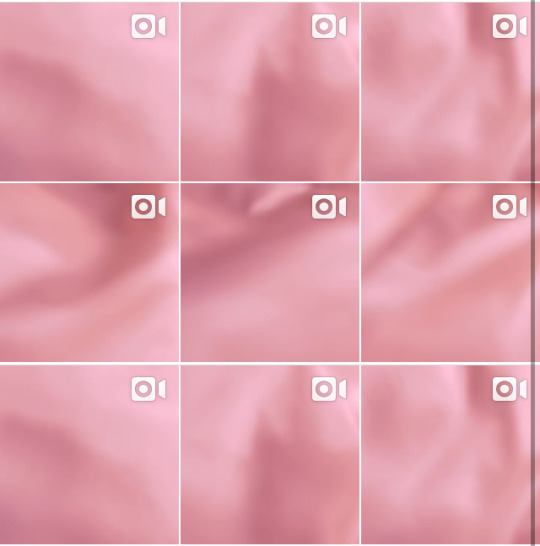
Images fail us 2017 Instagram interface, video Dimensions variable
A series of short video works, the delicate, sensuous image of fabric billowing in wind is paired with quotes that confrontationally deal with the ideas of image, aesthetic beauty, consumerism, and representation. A juxtaposition between enticement and antagonism that forces us to engage with the visual culture we find ourselves immersed in today.
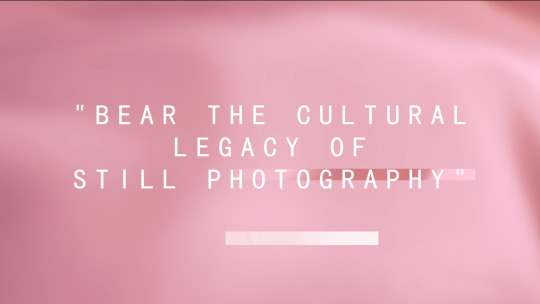
I created this by selecting various texts that relate to the idea of the image and representation. Inspired by Inflammatory Essays by Jenny Holzer, I edited text and overlaid it over clips of billowing fabric -- completely capitalised, starkly positioned over the screen. Using image editing software, sound effects, and video-editing, I created a glitch effect that would overwhelm the image over time; dominating the lo-fi lullaby, chime-like music that each video begins with.
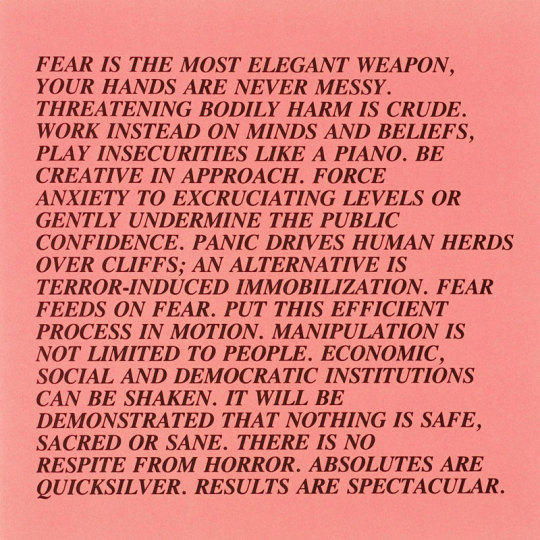
[Jenny Holzer, Inflammatory Essays (1979-82)]
This plays with the idea of our innocent acceptance of images and its eventual descent into noise, saturation, and meaninglessness; replete with falsehoods and emptiness.
Facebook.
Here, the platform is associated with the act of sharing -- of handing down information. We show our support for articles, headlines, images, videos that we approve of with a simple click -- a most convenient, non-committal means of expressing identity.
I was interested in the creation of another manifestation of identity for this experimentation with the Facebook platform. Referencing K. from The Trial by Franz Kafka, I created Kay Landmesser, a fictional entity that would be the embodiment of my experiment.
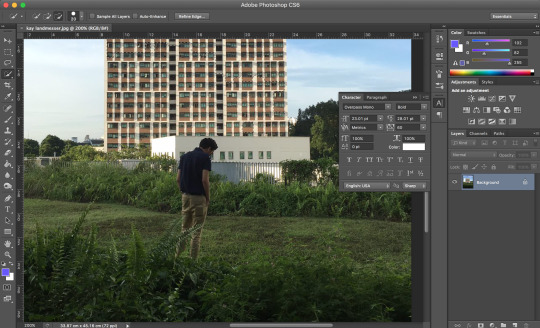
Utilising image editing software, I edited the background of an existing photo of my self standing before regular buildings to one before a landscape of sand dunes and exposed earth -- a simplistic representation of the land surveyor.
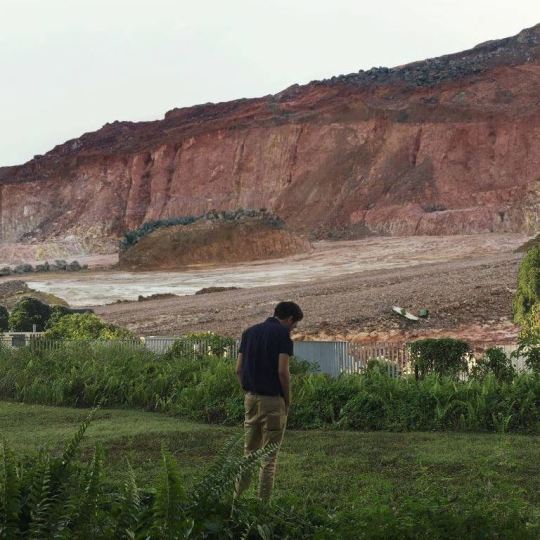
This image would hence become my profile picture for the false account -- a visual manifestation of falsehood and imagined character.
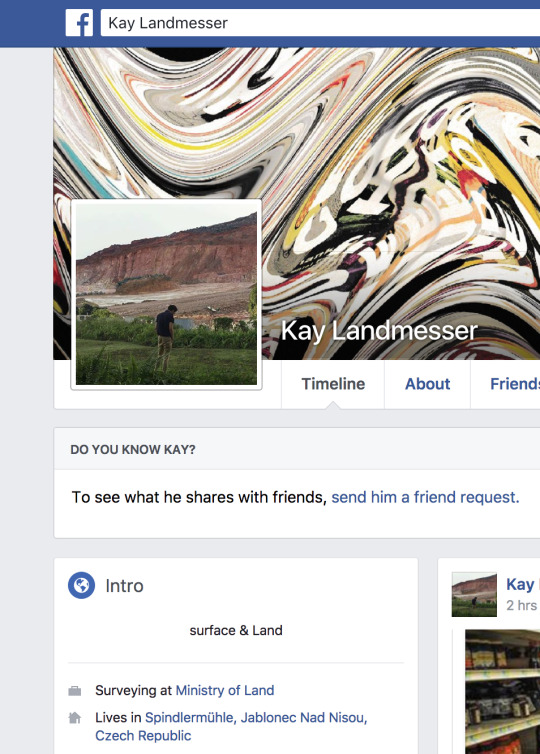
Man hands on misery to man 2017 Facebook interface, hyperlinks, text Dimensions variable
Through the creation of this false character, this artistic experiment charts my attempt to immerse myself in the identity of Kay, taking up a subject position disparate from the self. Processes of identity immersion/perpetuation through Facebook become heightened and deliberate – how does the sharing of articles, images, and links reveal one’s identity? Can we possibly attempt to replicate the underlying thought processes and selection of this material for another individual? Are we able to truly grasp the intangible qualia of a person even through the digital sphere based on the act of sharing and handing on information? Can we reverse-engineer identity based on selection of information and material?
As I shared more videos, articles, and statuses based on what I imagined this false character would, it became clear how difficult it was to attempt to mimic such intuitive processes of sharing and handing on information that an individual deems important. I was further attracted to the visual language of the posts I shared -- mostly related to civil engineering and technical tools related to land surveying. Such fields were so distant from my interests that such information felt distanced, surreal, displaced from the world within which I exist in.
It emphasises to me the disparity in the information each individual receives; so fine the data and details and demographics that we often never see swathes of information not relevant to our construction of self.
Conclusion.
The stuttering leaps between interfaces, intertextual references, and identity notes thus allow my Internet artwork to communicate the various fragmentations of identity, digitally dissipated over platforms.
To evaluate, I do feel my work relies a lot more on explanation of processes. Should one experience the work alone without descriptions of processes and write-ups, the themes and concepts may not have been so intuitively communicated. As such, write-ups are present within the work itself, which may reduce immersivity of experience.
0 notes
Text
Week 6 Reflection - Pecha Kucha
Reflect in your journal about How successful your Petcha Kutcha described your Assessment task – are the ideas expressed in a contemplated manner did your models diagrams images show a considered creative approach?

Given the fast-paced twenty-second-per-slide nature of Pecha Kucha, I felt a more fragmented and organic progression of image/idea presentation would work best with the medium. As such, my slides were tied together with one general theme, presented in a fluid and intertextual manner, with an almost stream of consciousness-type exposition, where advancement to the next slide brought on a new, associative line of thinking that developed the theme I set out to explore.
For this post, I will loosely trace my thinking process throughout the presentation and finish with an evaluation of how successfully my Pecha Kucha described my assessment task.
Firstly contemplating the half-statements “I am, I like, I want to”, I noted that these were the beginning of what would be definitive responses to more complex questions such as “Who are you?” “What do you like?” and “What do you want?”. Believing that a more nuanced understanding of the individual had to occur outside the context of definitive statements, I shifted the focus to the idea of informational saturation with today’s digital culture. Using a graph demonstrating white noise, I created an associative link to Don Delillo’s novel, White Noise.

“[W]e're suffering from brain fade. We need an occasional catastrophe to break up the incessant bombardment of information. [...] The flow is constant, [...] Words, pictures, numbers, facts, graphics, statistics, specks, waves, particles, motes. Only a catastrophe gets our attention. We want them, we need them, we depend on them. As long as they happen somewhere else.”

[from White Noise by Don Delillo.]
I sought to examine the impossibility of communicating identity through quantifiable statements -- how can any statement we make transcend the “bombardment of information” every individual faces on a daily basis? Surely, to answer with “I am, I like, I want to” would be inadequate -- and I hoped to push this further by suggesting these were the wrong questions to be asking to begin with if we were to truly determine identity.

Exploring the theme of questioning as an act of introspection, self-reflection and information gathering, I explored associations that immediately sprung to mind where the idea of questioning was engaged with, such as the opening sequence of the film Lola Rennt (Run Lola Run), directed by Tom Tykwer.
“Man... probably the most mysterious species on our planet. A mystery of unanswered questions. Who are we? Where do we come from? Where are we going? How do we know what we think we know? Why do we believe anything at all? Countless questions in search of an answer... an answer that will give rise to a new question... and the next answer will give rise to the next question and so on. But, in the end, isn't it always the same question? And always the same answer?”

[Still from Run Lola Run (1998) dir. Tom Tykwer]
While these associations helped to deepen the exploration of theme, I returned to the idea of informational-saturation by expressing an overall fatigue with the quantification, compartmentalisation, and simplification of the individual identity in relation to digital culture.

[Excerpt from The Garden of Proserpine by Charles Algernon Swinburne]
To evaluate, I feel that my presentation helped me contemplate and further my understanding of the issues and themes I hoped to address within the first assignment. I began thinking more of the way in which the work could be presented and suggested at the end of my presentation that, since film is my medium of choice, I could create a video essay à la Hito Steyerl’s How Not to be Seen: A Fucking Didactic Educational .MOV File (2013).
vimeo
[Video from https://www.artforum.com/video/mode=large&id=51651]
I am still thinking of how to present this in an interesting manner -- perhaps this is something my presentation has failed to communicate adequately, in terms of concrete specifications or the formal specifications of the work. It is, however, helpful to know that these are the areas I will have to work upon. Perhaps some interactive manner of presenting the work.
0 notes
Text
Week 6 - Glitch Portrait
Make a self-portrait in a glitch style (can be video or a series of stills

The final result of my experimentation with glitch portraiture! Allow me to journal the entire process of creating this gif.

I started with a self portrait taken against a plain background -- this was sort of a childish homage to a promotional video for the I am LGB performance work/artistic experiment, which features Ray Langenbach in an all-white outfit and wig as glitch effects progressively overwhelm the image. I hoped to recreate the same sense of disintegration and perhaps communicate an off-kilter aesthetic sensibility.

[Still from video, What would you choose? on I AM LGB Facebook page]
I began by experimenting to understand what each attempt at image data manipulation via TextEdit would achieve, trying to learn how I could organise the chaos of the glitch aesthetic. I divided these experimentations of image data manipulation into four processes: Restructuring, reduction, repetition, and addition.

Restructure. Rule: Cut a large amount of text from TextEdit and restructure it by pasting the text and returning the data to a position it does not belong to. Save the image. Amusingly, the literal restructuring/repositioning of text resulted in my hair being displaced to the bottom of the image. Reminiscent of a malfunctioning film projector, it strangely communicates some sense of progression -- as if a new image from below will appear and begin to animate the portrait.

Reduction. Rule: Cut a large amount of text from TextEdit and Save the image without returning the data to the image. Through the reduction and negation of data from the image, a whole slice of the portrait disappears and is replaced by grey. It communicates an almost violent removal of splices of the image, with a single bar visually cutting through the skull, and the large field of grey at the bottom of the image only adding to a sense of incompletion and loss.

Repetition. Rule: Randomly select a short phrase within the data. Copy and paste it repeatedly until it fills the TextEdit window. Do this multiple times for different phrases. Save.

It seems the act of repeating a phrase only affects a single bar within the image -- this is a recurring trend I notice through experimentation. Unless a large chunk of text is tampered with, the usual result is a small bar being shifted out of place or discoloured. Logical enough. The act of repetition did not produce as dramatic an effect as I had hoped for, and only created a visually interesting image when the process of selecting a phrase and repeating it was conducted multiple times to create multiple interrupting and discoloured bars in the final image.

Addition. Rule: Select a passage of text external to TextEdit. Copy and paste it into the data. Placing a large passage of external text within the data, I expected a dramatic change in the image -- however, regardless of the length of the passage, it seems it only discoloured a single horizontal bar within the image, rather similar to the act of Repetition as above. I was struck by the positioning of this bar, though -- serendipitously right below the eyes. It draws attention to the portrait and to the eyes of the figure.
Finally, after experimentation, I decided that the best way to visually present all the images was through animation. Creating a gif allows one to see the various ways in which the glitch manifests in and manipulates the image, creating a visually exciting, jittering, stuttering image that communicates the corruption and entropy of data. I felt that animation was the most natural way of experiencing glitch as an aesthetic -- truly sensing the glitch as “noise artefacts” that emerge in the dynamic processes of encoding and decoding, as according to Rosa Menkman in The Glitch Moment(um).

I am quite excited by the aesthetic and conceptual capabilities of glitch, and this exercise was a very entertaining introductory exploration of these possibilities.
0 notes
Text
Week 5 - Electrical Component Monologue
1) Take picture of one electronic component or tool (break some old machine etc.) 2) Write a small monologue on the picture ask yourself and reflect - what would that object say if it could speak?


Monologue for a Digital Watch
I don’t know why I was chosen to be taken apart. Then again, I don’t know a lot of things – I only know time. I know I was handed over to my current owner once my previous owner was done with me. I also know that I am a cheap thing. I see myself on others’ wrists when they want something that can suffer wear and tear along with them without too much worry. I hear people have allegedly used me for dangerous things – it is a good thing the people I know are simple-minded. They do not have time for plots or plans or schemes or attacks or aggressions or civil disturbances.
My current owner only used me in military settings – brought out into the forest and pushed into mud or for training while coated in perspiration or for some other tedious thing. I am still stained with mud and dirt in some places. Too many of these exercises has left me broken – my straps grew brittle with use and snapped off. But I served my purpose for my owner in the military – as long as I could tell time and count time. I know my owner doesn’t like the military very much – he says he is a “pacifist”. I imagine it is a fancy word for “coward”. But then again, I only know time.
I have an alarm. It is still set to 5.00am, the time he once had to wake up every morning to get ready – for reveille, for breakfast. But it no longer sounds. My owner no longer finds himself in military settings. He no longer wakes or sleeps at a fixed time. He works in the night and wanders through the day like a ghost half asleep. I am sure he finds the irregularity frightening – I can’t imagine a life without absolute precision. Without the constant escalation of seconds -- the constant accumulation of minutes, hours, days, months, years, numbers, digits, quartz movements, volts, shifts, beeps, lights, sounds, alarms, and surprises. I wonder if my owner craves that regularity again. I wonder if he wishes for that same neat structure and simple logic. I wonder if the alarm will ever sound again. I don’t know. I only know time. I only know accumulation. I don’t know about loss. There is nothing to lose but time.
I only know time, but I wonder where all the time has gone.
0 notes